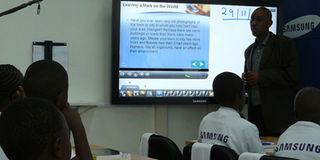Let’s rethink teaching methodologies

Edward Njoroge, a senior teacher at Lavington Primary School teaches using e-learning. PHOTO| FILE
What you need to know:
- Teachers can create online collaborative groups, administer and provide educational materials, measure student performance and communicate with parents, among other functions.
- Storybird aims at promoting writing and reading skills in students through storytelling.
Many schools use conventional teaching methodologies, where students must be in the classroom. Ironically, even the distance learning modules championed by universities were least prepared for the disruption occasioned by the Covid-19 pandemic. Schools and universities are now closed.
However, hundreds of digital education tools have been created for the purpose of giving autonomy to the student, improving the administration of academic processes, encouraging collaboration and facilitating communication between teachers and learners.
Edmodo connects teachers and students and is assimilated into a social network. Teachers can create online collaborative groups, administer and provide educational materials, measure student performance and communicate with parents, among other functions. It has more than 34 million users who connect to create a learning process that is more enriching, personalised and aligned with the technology and the digital environment.
EDUCATIONAL GAMES
Socrative was designed by a group of entrepreneurs and engineers passionate about education. It allows teachers to create exercises or educational games, which students can solve using mobile devices — whether smartphones, laptops or tablets. Teachers can see the results of the activities and use them to modify the subsequent lessons to be more personalised. This one can be very useful in CBC.
Project allows you to create multimedia presentations with dynamic slides in which you can embed interactive maps, links, online quizzes, Twitter timelines and videos, among others. During class, teachers can share with students academic presentations visually adapted to different devices.
Thinglink allows educators to create interactive images with music, sounds, text and photographs. These can be shared on other websites or social networks such as Twitter and Facebook. It offers the possibility for teachers to create learning methodologies that awaken the curiosity of students through interactive content.
TED-Ed allows creating educational lessons with the collaboration of teachers, students, animators — generally people who want to expand knowledge and good ideas. This website allows democratising access to information for both teachers and students. Here, one can actively participate in others learning’
The website cK-12 seeks to reduce the cost of academic books for the K12 market. To achieve its objective, this platform has an open source interface that allows creating and distributing educational material through the internet which can be modified and contain videos, audios and interactive exercises.
EDITORIAL STANDARDS
It can also be printed and comply with the necessary editorial standards in each region. The books created in cK-12 can be adapted to the needs of any teacher or student.
ClassDojo is aimed at improving student behaviour: Teachers provide their students with instant feedback so that good disposition in class is ‘rewarded’ with points. Hence, students develop a more receptive attitude towards learning.
It also provides real-time notifications to students — like ‘Well Done David!’ and ‘+1’ — for working collaboratively. The information that is collected about student behaviour can be shared with parents and administrators via the web.
This platform, eduClipper, allows teachers and students to share and explore references and educational material. In it, you can collect information found on the internet and share it with the members of previously created groups, which offers the possibility to manage more effectively the academic content found online, improve research techniques and have a digital record of what students achieved during the course.
Likewise, teachers can organise a virtual class and create a portfolio where all the work is stored. Storybird aims at promoting writing and reading skills in students through storytelling. In it, teachers can create interactive and artistic books online through a simple and easy-to-use interface.
CREATE PROJECTS
The stories created can be embedded in blogs, sent by email and printed, among other options. Teachers can also create projects with students, give constant feedback, and organise classes and grades.
In Animoto you can create high-quality videos in a short time from any mobile device, inspiring students and helping improve academic lessons.
The interface is friendly and practical, allowing teachers to create audiovisual content that adapt to educational needs.
Kahoot! is based on games and questions. Teachers can create questionnaires, discussions or surveys that complement academic lessons. The material is projected in the classroom and questions answered by students while playing and learning. It promotes game-based learning, which increases student engagement and creates a dynamic, social, and fun educational environment.
These tools can come in hardy during the coronavirus shutdown. Let schools and universities explore them.
Mr Gikunda ([email protected]) and Ms Awuor ([email protected]) are project planning and management master’s students at the University of Nairobi.




